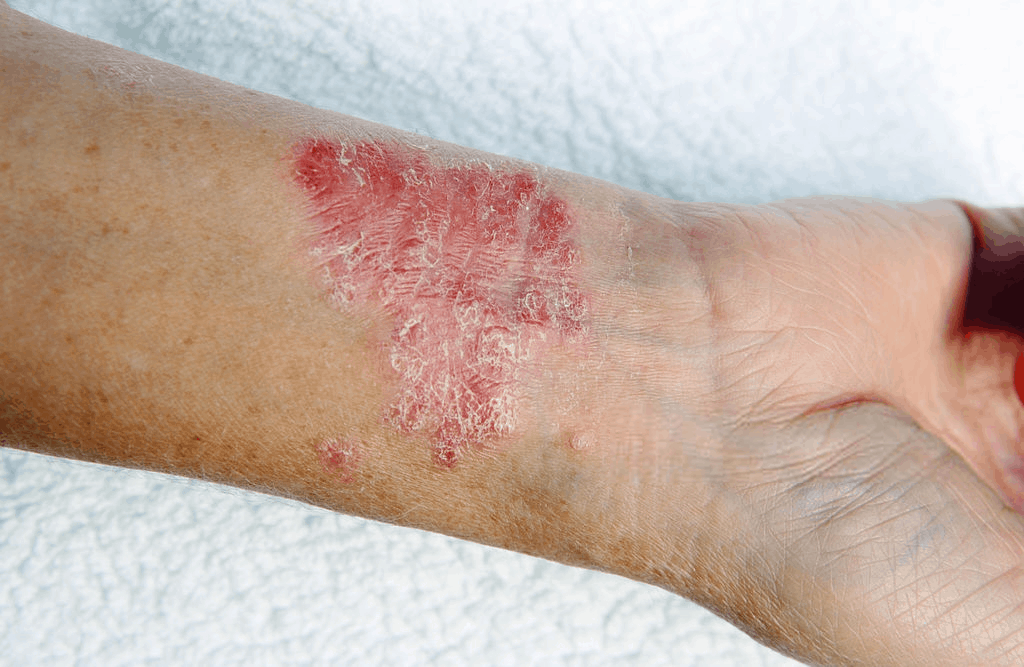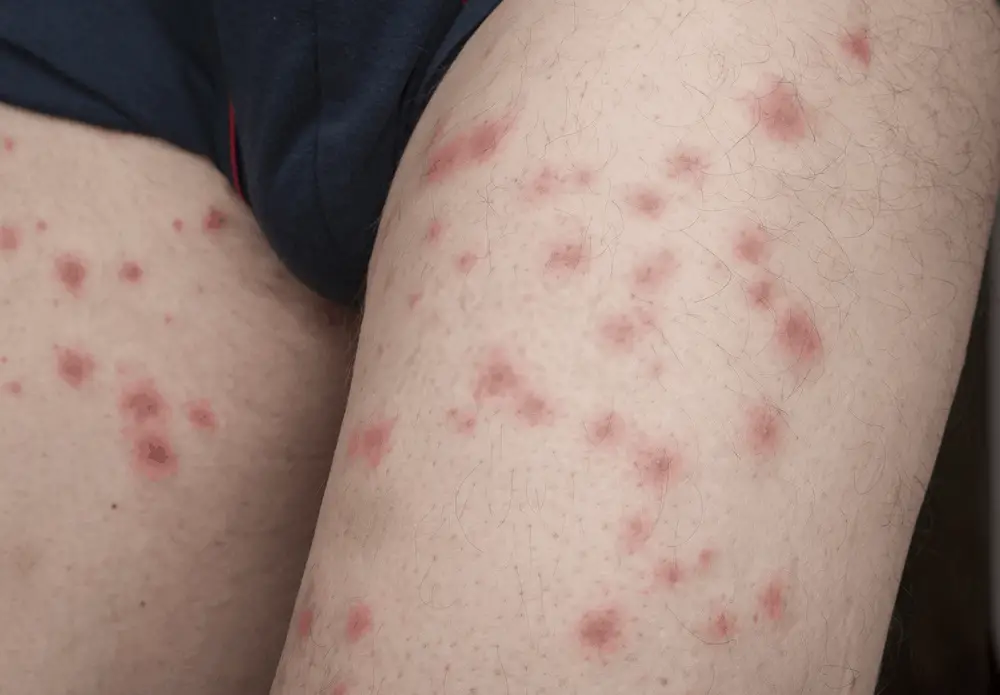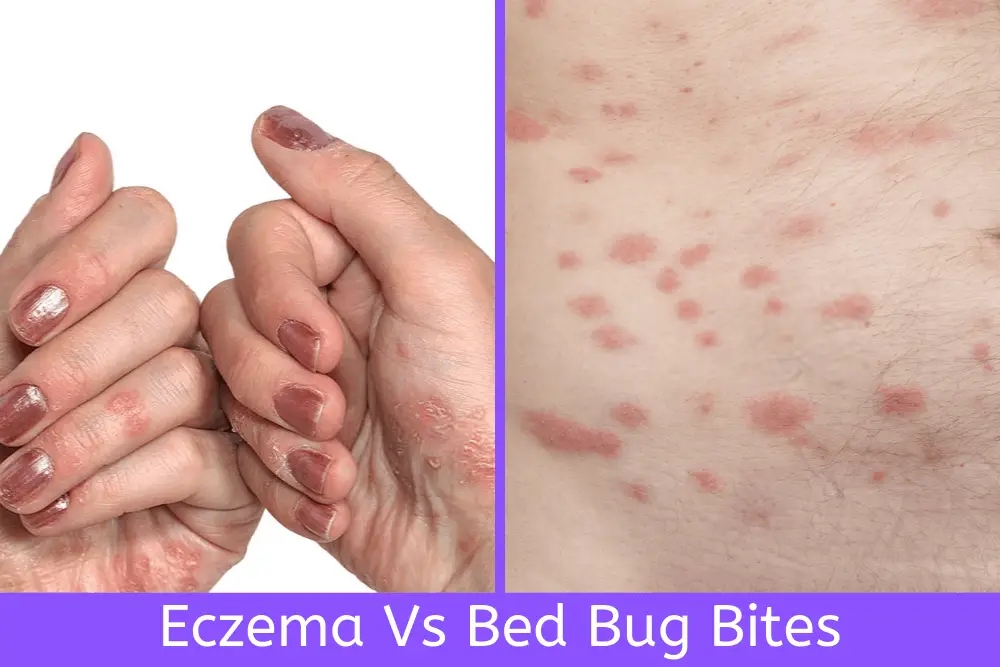Trying to figure out the difference between eczema vs. bed bug bites? If your skin is covered in itchy red welts or splotches, your first thought might be that you are dealing with eczema. It is, after all, a very common skin condition. But you might find yourself looking at your bed and wondering, “Could it be bed bugs?”
Bed bug bites and eczema can appear and feel similar. But there are some telltale signs that can help you distinguish between the conditions, like the exact formation pattern for the red itchy spots, and whether you note signs of bed bugs in your home. In this article, we’ll help you differentiate eczema vs. bed bug bites with detailed information on symptoms, diagnosis, treatment and more.
Symptoms of Eczema
Let’s start by talking about eczema. This is a chronic skin condition that causes itchy, reddish, or brownish patches of skin.
The National Eczema Association lists the following types of eczema:
- Atopic dermatitis
- Contact dermatitis
- Dyshidrotic eczema
- Nummular eczema
- Seborrheic dermatitis
- Stasis dermatitis

Each of these types of dermatitis presents itself with different symptoms. Thankfully, many of them are quite specific.
- Stasis dermatitis specifically involves circulatory issues that are generally found around the ankles and the lower parts of the legs.
- Seborrheic dermatitis takes the form of flaky, oily skin. While it may occur anywhere, it is frequently on the scalp, where it is called “dandruff.”
- Nummular eczema causes round “coin” lesions. They usually have darker borders and lighter interiors, but this may or may not be pronounced or obvious.
- Dyshidrotic eczema produces blisters, which may form on the hands or feet.
- Contact dermatitis is a form of eczema which flares in response to contact with a substance to which the skin is hypersensitive, sometimes an allergen. It is characterized by a red rash that may itch or burn. Blisters can form that ooze.
- Finally, atopic dermatitis is the condition that people most commonly are referring to when they say “eczema.” It seems to be immune-related and is chronic in nature. It can go into remission for periods and flare for others. Symptoms include skin, which is itchy, red, dry, scaly, and sometimes breaks into weeping sores. It tends to look like a splotchy rash, but sometimes it can look like more scattered red spots which could be mistaken for bites. It can show up on the face, back, legs, hands, or other parts of the body.
So, when it comes to recognizing eczema vs. bed bug bites, some types of eczema are easier to differentiate from bed bug bites than others.
For example, if you spot those distinctive “coin” lesions, there is a good chance it could be nummular eczema.
If your hands are covered in raised blisters, dyshidrotic eczema is a possibility.
Have red spots which are somewhere other than your legs? You likely (though not definitively) can rule out stasis dermatitis.
Symptoms of Bed Bug Bites
Now let’s take a look at the symptoms of bed bug bites.
Bed bug bites:
- May be flat or raised
- Are small
- May cause redness, itching, and inflammation around them
- Can turn into blisters
- May take anywhere from seconds to days after infliction to become noticeable (sometimes weeks)

Hypothetically, a bed bug can bite you anywhere. But Orkin writes, “Bites are commonly found on the parts of the body that are more likely to be exposed to bed bugs during sleep – the hands, neck, face, shoulders, legs, and arms. While not always the case, bed bug bites are often grouped together in a small area and at times may occur in a line or a zigzag pattern.”
Interestingly enough, there can be variations in the exact appearance and symptoms of bed bug bites from one person to the next.
Orkin explains this as well, stating, “Since people will have various sensitivities to the bed bug’s bite, the size of the bite will vary, as well. Another factor that influences the size of a bed bug reaction is the number of times a person is bitten. Bite reactions of people bitten many times are also variable, and their response may be either more or less intense as the number of bites increases.”
Intriguingly, there are people totally unaffected by bed bugs. So, two people could sleep in one infested bed, and one person could break out into itchy bites, and the other might never even show a sign of having been bitten.
Rarely, an individual can react with life-threatening symptoms to bed bug bites, such as fever or labored breathing.
Because there are so many variations in the timing and symptoms of bed bug bites, differential diagnosis can be a challenge on your own.
Small, scattered spots in a zigzag pattern may very well be bed bug bites. But they could still feasibly be eczema.
A splotchy, large rash is more likely to be eczema than bed bug bites—but you still don’t know, since highly reactive skin could hypothetically form a large swath of inflammation around a cluster of bites. Scattered spots that are not in a zigzag pattern may be bed bug bites, or they could be eczema. And don’t forget that there are other skin conditions or bites which could be causing your symptoms as well. Bed bug bites and eczema are not the only possibilities.
Diagnosis of Eczema
Sometimes, you may be able to figure out if you have eczema on your own. It can start at any age, so you do not need to have had it since childhood to develop it later.
If you go to see a doctor, a simple clinical examination should be sufficient to establish a diagnosis. Occasionally, your provider may want to conduct a patch test.
Diagnosis of Bed Bug Bites
Mayo Clinic suggests that you look to your home and not just your body to try and figure out whether you have bed bug bites. Orkin also recommends taking a look at your sheets.
Here is some of what you can be on the lookout for:
- Are there any spots of blood on your bedsheets? That is a pretty good indication that you’re being eaten by bed bugs at night. Keep in mind that the stains may be more brownish than reddish in some cases. This is what happens when blood dries.
- Do you see any little brownish or blackish splotches along the seams of your mattress? This could be the waste that the bed bugs have excreted.
- Try taking a whiff of your mattress or sheets. Do they smell mustier than usual? Is there a faint sweetness to the odor? That could indicate the presence of bed bugs.
- See if you can spot any moltings from the bed bugs. These will be yellowish in color. They may be hard to spot as they could easily blend in with your mattress and sheets and will be quite minuscule.
Bed bugs are very tiny (the size of a poppy seed is about equivalent to the size of a bed bug), and they are geniuses at stowing themselves away, where nobody will ever find them. But sometimes you can spot them if you are cleverer than they are. Anywhere there is a narrow space like a crack in the headboard of your bed or even a nearby bedside table, that is where you might encounter hiding bed bugs. They wander further than you might reckon and could be up to 8 feet away from your bed (that’s according to Orkin).
Treatment of Eczema
Now that we’ve talked about diagnosing eczema vs. bed bug bites, let’s talk about approaches that you can take to treating both. We’ll begin with eczema.
The NHS writes, “Treatments for atopic eczema can help to ease the symptoms. There’s no cure, but many children find their symptoms naturally improve as they get older.”
So that is good news if you are looking this up on the behalf of your child. Here are some of the treatments that the NHS recommends for eczema sufferers:
- Emollients (also known as moisturizers).
- Topical corticosteroids.
- Antihistamines (in especially itchy, inflamed cases).
- Topical pimecrolimus or tacrolimus.
- Bandages.
- Prescription medications prescribed by a dermatologist.
It also is recommended that you go out of your way to avoid scratching. Scratching will just make the inflammation worse. If bacteria get into open sores, this could result in a secondary infection.
Treatment of Bed Bug Bites
What if you have bed bug bites? In terms of actual treatment, you don’t have to do much of anything. Bed bug bites heal without intervention. It usually takes a couple of weeks, sometimes less.
If your bites are particularly itchy or painful, you might try taking an antihistamine. You also might use hydrocortisone cream.
Again, avoid scratching. This will make it less likely that you will develop a secondary infection that could require further treatment.
Prevention of Eczema
With both eczema and bed bug bites, prevention is key. Therefore, it’s important to figure out which of the two conditions you have.
To prevent eczema:
- Flares of eczema often happen in response to exposure to various triggers. You will need to take notes to identify what your triggers are. They could involve anything from heat exposure to certain detergents to milk or eggs. Once you know what your triggers are, avoid them.
- Do not just apply moisturizers as a treatment for an acute flare-up. Use them as a preventative measure as well.
- For specific forms of eczema, certain other preventative measures may be useful as well. For example, dandruff shampoo can be helpful with seborrheic dermatitis.
- While the simple steps above are adequate for most mild to moderate eczema cases, additional preventative treatments may be available to you if you have a severe case that resists more moderate management steps.
Prevention of Bed Bug Bites
If you have bed bugs rather than eczema (or in addition to eczema), you will simply continue to suffer from bites if you do not get to the root of the problem and get rid of the bed bugs.
In fact, you can even move to a new house and bring bed bugs with you. So, you must eradicate them.
The EPA provides recommendations here for killing the bed bugs once you locate them, including non-chemical methods such as heat or cold treatment or steam cleaners.
Once you believe you have eliminated the threat, use traps or interceptors to prevent future infestations of your furnishings.
Eczema Vs Bed Bug Bites: Key Points
We have now explored the similarities and differences between eczema vs. bed bug bites. Let’s quickly review the key points:
Eczema:
- Presents itself in several different ways depending on the specific type present. It will probably be itchy and may show up as reddish or brownish patches or spots that can look quite similar to or quite different from bed bug bites.
- It’s a chronic condition that may flare-up at different times.
- It does not have a cure.
- It can be managed using conservative treatment and prevention protocols in most cases including moisturizers, avoiding triggers, and using medications.
Bed bug bites:
- Appear as small, itchy red spots that may or may not be raised. These sometimes blister. It can take seconds or weeks for them to appear after you are bitten. They may or may not have a zigzag pattern.
- Signs of bed bugs such as blood or excrement on sheets or on your mattress may be present.
- While bed bug bites resolve on their own, they will continue to appear until you remove the infestation.
Hopefully, you can figure out whether you have eczema, bed bugs, or both on your own, and come up with a plan to get your symptoms under control. But, remember, it can always be helpful to consult with a medical professional, especially if you are worried that you might have something else going on.
Related Questions
1. How can you tell the difference between bed bug bites and flea bites?
Flea bites and bed bug bites look very similar. Flea bites are less likely to swell than bed bug bites. They also are more likely to be clustered together and located near the ankles. The zigzag pattern which is common with bed bug bites is not associated with flea bites (but could form through coincidence).
2. What scent keeps bed bugs away?
If you are looking for a simple, yet natural way to ward off bed bugs, they reportedly do not like the smells of lavender, cinnamon, tea tree oil, citrus or rubbing alcohol.
Recent Posts
Best Sunscreen for Babies With Eczema: Top 13 Picks (Updated 2020)
With summer always on the verge, it’s never too early to start looking for the best sunscreen for babies with eczema. Oh yes, even though winter is on the rise at the time of this article...
Cercarial Dermatitis: Symptoms, Causes, Diagnosis, & Treatment
If you swim a lot in freshwater, sooner or later, you may become familiar with cercarial dermatitis. A typical scenario goes like this: You’re enjoying a relaxing afternoon swimming in a lake...

